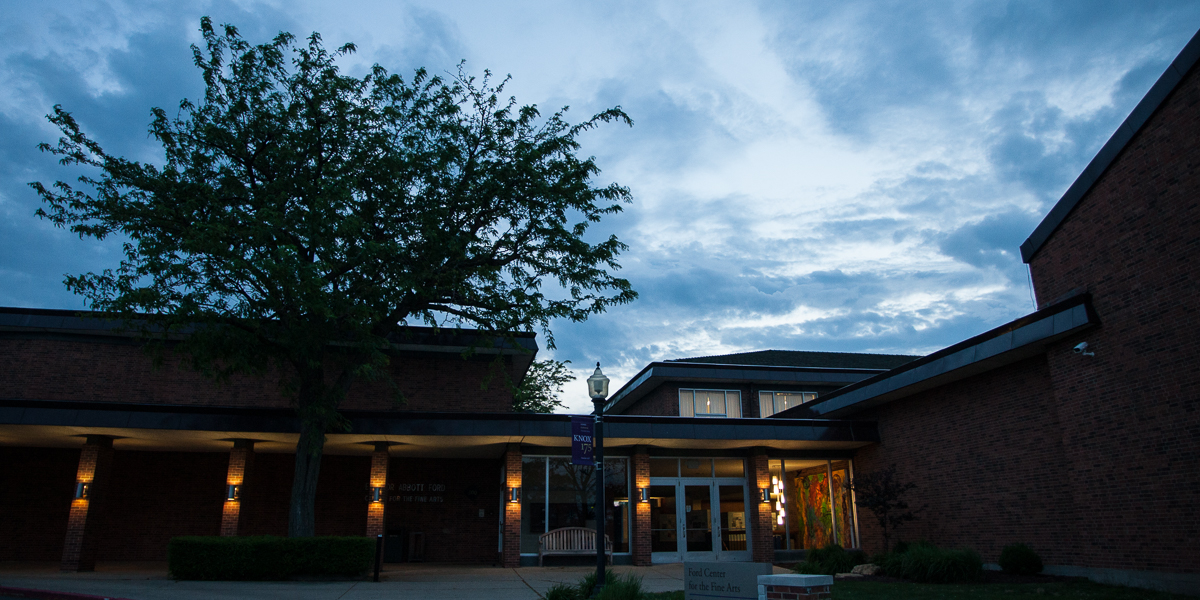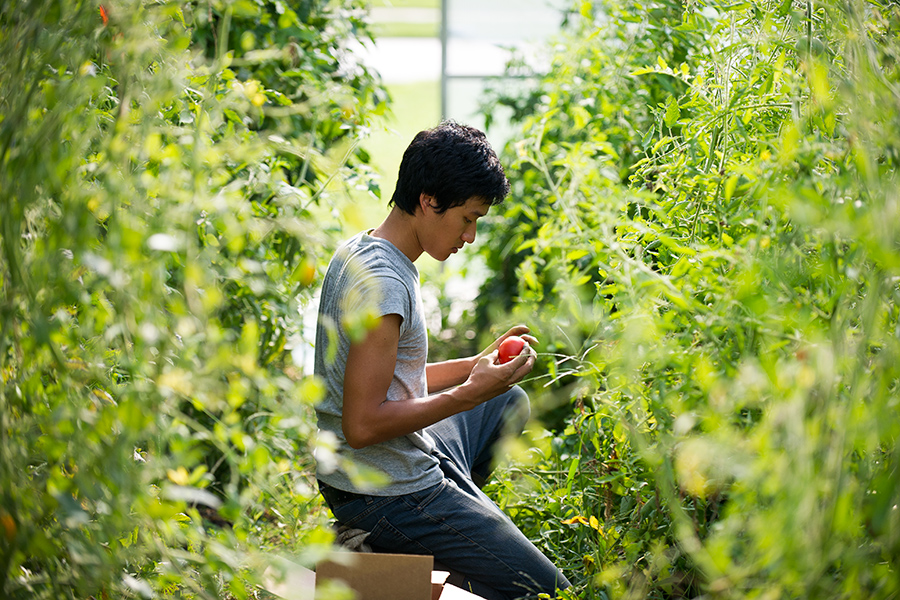


Office of Communications
2 East South Street
Galesburg, IL 61401


By Jane Carlson
Radish magazine
When tomatoes are harvested at the Knox College farm, they don't have far to go. They're hauled a couple blocks down Berrien Street to dining services, where they're cooked down into sauce, vacuum-packed, and served to students.
The same goes for the greens and other produce that are now grown in spring and fall in the one-acre outdoor area and two high tunnels that comprise the college's operation on South Academy Street in Galesburg -- about a 100-yard trip for fresh use on the salad bar.
This year, the farm provided approximately 2,000 pounds of produce for use in campus dining facilities. Clearly marked as locally-produced food, the offerings have been incredibly well received by students.
"Students wanted to produce their own food," says Ramona "Froggi" VanRiper, director of Campus Sustainability Initiatives, on the burgeoning local food production that is part of the college's overall sustainability efforts.
At the farm, one of the high tunnels is devoted to tomato production in the summer, with additional crops grown in spring and fall, while the other is used as an educational and experimental garden, both for the college's urban agriculture course and for summer programs like College for Kids.
Both high tunnels were constructed in 2014, with the goal of extending the growing season and producing more food. The "tomato" tunnel is 30-by-100 feet, and was funded in part by student activity fees. The educational tunnel is 30-by-60 feet, and was made possible by a grant from the Galesburg Regional Economic Development Association, awarded to the college through the efforts of Peter Schwartzman, chair of the environmental studies program.
The farm is staffed by a paid student worker, as well as volunteers. For sophomore Coral Weinstock, volunteering at the farm is about putting theory into practice. Her parents had a garden and she has worked in a food co-op, but this is her first experience truly getting her hands dirty growing food. "I love my Knox classes," she says, "but it's really gratifying to come out here and work on this."
The decision to focus on tomatoes in the summer, VanRiper says, came after contemplating the growing season in relation to the academic calendar. With no classes in session during the summer at Knox, it made sense to grow other produce in spring and fall that could be used fresh in the cafeteria, and use the summer season to grow something in bulk that could be preserved easily for use in the fall.
The first year's supply of tomato sauce lasted midway through the fall term. Kale, spinach, daikon radishes and beets were planted in the tunnel once the tomato season was over. A harvest of green tomatoes also was turned over to dining services.
In addition to educating students about the benefits of a more localized food chain, VanRiper says, the farm also encourages them to try new foods.
While there's plenty of traffic going from the farm to dining services, there's just as much traffic the other way. VanRiper works with Helmut Mayer, director of dining services, and Scott Maust, director of facilities services, to ensure the farm's soil is amended with campus-generated compost.
Pre- and post-consumer food waste are separated into bins in the kitchen. Paper waste is pulped and dehydrated, and all of it is transported back down Berrien Street to the composting bays at the far edge of the farm. Through these efforts, 95 percent of organic waste on campus is diverted for composting and no pesticides are used on the farm.
"None of this would be happening without exemplary collaboration," VanRiper says.
In addition to the farm, Knox's sustainability efforts include a commitment to purchase 100-percent renewable energy and recycled paper, reduction of solid waste through recycling and composting, purchasing energy-efficient computers, inclusion of sustainability in the college's strategic plan, and a focus on environmental issues on campus as part of new student orientation.
At the Gizmo, the college's snack bar, VanRiper has turned disposal into a teaching opportunity, with clearly labeled bins for landfill, compost, recycling, and food. Posters atop the bins feature examples of each category.
Pairs of bins for waste and recyclables also have been placed throughout campus, and through VanRiper's direction, the college has done several "zero waste" events, wherein all materials used can be composted or recycled. Those events, VanRiper says, extend the message to alumni and visitors to campus, and even to caterers and vendors who may learn something about solid-waste reduction through the process of putting on an event on campus.
Alumni and vendors aren't the only ones taking notice of the many efforts underway at Knox: Mayer was awarded the Golden Beet Award from the Illinois Stewardship Alliance in 2011 for his use of locally grown foods in student meals. In 2014, Knox was honored with a Gold Level Campus Sustainability Compact Award, one of four such awards presented to colleges and universities in Illinois. Also in 2014, Knox was named to the Sierra Club's list of "Cool Schools" for sustainability-related initiatives.
The successes are several years in the making. Knox convened a Sustainability Task Force in 2008, drawing on faculty, staff, trustees, and students to review and implement sustainability initiatives. Input and initiative from students has been key throughout the "greening" of the campus, including the establishment of a full-time director to oversee and coordinate efforts. "The whole position exists because the students decided the campus needed it," VanRiper says.
Students can apply for funding for sustainability projects as well through the Student Sustainability Fund, also established in 2008. The fund is administered by the Student Senate Sustainability Committee, which deals directly with environmental issues on campus.
The goal of all of these projects and initiatives, VanRiper says, is to reduce the college's carbon footprint, but also to instill habits of stewardship and sustainable practices in students and other members of the campus community.
Reprinted with permission from Radish magazine
Published on April 09, 2015